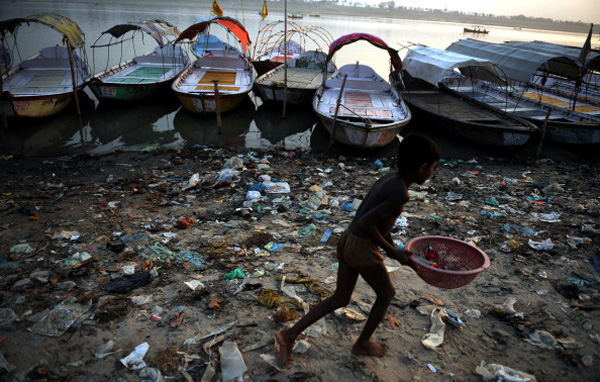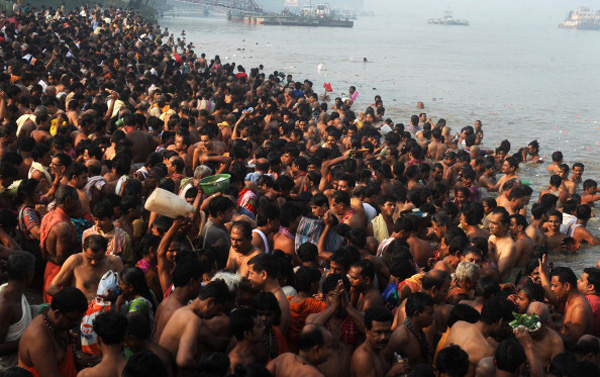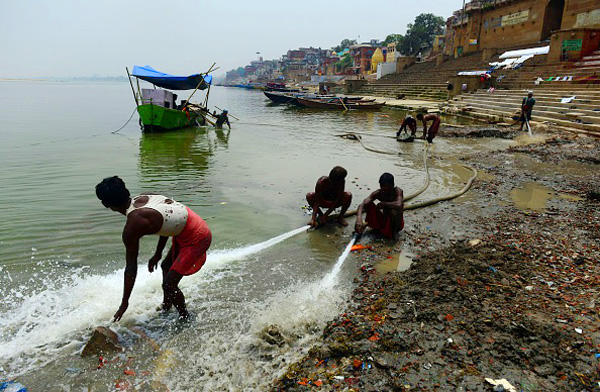'Save Ganga' handed over to corporates: masterstroke or disaster?

The unholy mess
- The Ganga is 2,525 kilometres long, and is pristine only for its first 14 kms
- In total, 118 cities and towns dump 3,636 million litres of sewage in the river each day
The stinking reality
- Only one-third of the waste is treated before being discharged into the river
- Now, the government wants to bring private players into sewage treatment
More in the story
- How private companies can make a profit by treating sewage
- Is privatisation the answer to the Ganga\'s problem?
That the Ganga is polluted is not news. The 2,525 kilometre-long river is known to be pristine only in its first 14 km, after which cities, industries and dams turn it into a stinking mess.
Of these, urban sewage is the biggest polluter. In total, 118 cities and towns dump 3,636 million litres of sewage in the river each day, of which barely one-third is treated.
Now, the Narendra Modi government plans to bring in private companies, such as Tata and L&T, to take up sewage treatment, according to reports.
This is an unprecedented step. In the history of action against Ganga pollution, there has never been a plan to privatise sewage treatment. Will it be a masterstroke or a recipe for disaster?
Why it matters to you

Photo: AFP/Diptendu Dutta
- Over 72 million people depend on the Ganga. Even if you're not one of them, rivers across the country face similar challenges caused by pollution. The success or failure in saving the holy river would shape the policy for these rivers.
- The only question is why the central government itself doesn't take up the job of treating sewage. It has already spent Rs 4,000 crore on cleaning the Ganga so far, and plans to spend another Rs 20,000 crore in the next five years.
Government's work so far
Very little has changed on the ground since the Modi government came to power and added 'Ganga rejuvenation' to the water resources ministry's mandate.
- It launched the National Mission to Clean Ganga (NMCG). One year later, in May 2015, it declared Ganga as the national river, and approved the Rs 20,000 crore funding.
- But work under the NMCG has been slow. The National Green Tribunal recently pulled up its officials, saying, "tell us one thing you have done so far that has succeeded."
In 2013, 14 of the 51 treatment plants along the Ganga were found to be non-functional
- Despite the importance of dealing with untreated sewage entering the Ganga, successive governments have dragged their feet on it. This could be because of prohibitive costs. According to an estimate by the urban development ministry, it will cost Rs 51,000 crore to upgrade sewage treatment facilities in all the 118 urban agglomerations along the Ganga.
- Treating urban sewage is the responsibility of local governments, i.e. municipal corporations and municipal councils. Now, the central government is proposing to bypass these local bodies by directly appointing private firms to do the job.
The pros

Photo: AFP/Dibyangshu Sarkar
By offering one of the most critical clean up jobs to private players, the government looks like it is washing its hands off the responsibility. But in light of the money required, bringing in private players may be the best way to manage the funding. Besides, the private players would be allowed to sell treated wastewater, which might make it a viable option.
- This was suggested in in 2013 by a study conducted by a consortium of seven IITs and 11 other research organisations. The study recommended that "service providers" (which can be private firms) can sell the water, which would lead to a net cost of just one paisa per litre, which is cheaper than all other alternatives, including 'decentralised' treatment i.e. treating sewage within housing colonies. The treated wastewater can be sold to industry, agriculture or even for domestic use (e.g. for flushing).
- While privatisation would bring in the necessary efficiency, it cannot be achieved without a monitoring mechanism, according to BD Tripathi, professor of environmental science at Banaras Hindu University, and expert member, National Ganga River Basin Authority.
"Privatising turned public sector companies from loss-making to profit-making entities. Private companies have an incentive to get the work done," he said. "But this has to be accompanied by a monitoring committee, which consists of not just government officials but also experts."
The cons

Photo: AFP/Sanjay Kanojia
The government hasn't gone into why the existing sewage treatment plants are running below their capacity.
- According to a 2013 assessment, of 51 treatment plants along the Ganga, 14 were found to be non-functional. The remaining were running at just a little more than half their capacity. In another study, the sewage treatment plant at Varanasi was found to operate at only one-third of its capacity.
- The main reasons for this, besides a funding crunch, was a lack of sufficient electricity supply. This will remain a concern, even if private companies are running the plants.
- While sewage treatment has taken a hit because of inefficient local and state governments, privatisation means these governments are excluded from the activity. Such sour relations may cause issues when the support of such governments is required for other activities.
"In the name of bringing in money, you are taking the job away from them. It looks like the Central government doesn't want the local leaders to be in the picture," said R Sridhar, managing trustee at Environics, an environmental not-for-profit.
- Privatisation also reduces the scope for participatory and transparent decision-making to manage Ganga's pollution, according to Himanshu Thakkar of the South Asian Network for Dams, Rivers, and People. "The private players have no experience in such activities, and besides, this business will not be their main priority," he said.
- Finally, unless the private players are successful in selling all the treated wastewater, the Ganga may still remain polluted. The report prepared by the IITs said that such wastewater is also harmful to the Ganga. In fact, they said that sewage, treated or untreated, should not be be discharged directly or indirectly, "into any river". But this means there should be enough demand, and infrastructure, for selling wastewater - and none currently exists.
First published: 30 October 2015, 8:55 IST






![BJP's Kapil Mishra recreates Shankar Mahadevan’s ‘Breathless’ song to highlight Delhi pollution [WATCH] BJP's Kapil Mishra recreates Shankar Mahadevan’s ‘Breathless’ song to highlight Delhi pollution [WATCH]](https://images.catchnews.com/upload/2022/11/03/kapil-mishra_240884_300x172.png)

![Anupam Kher shares pictures of his toned body on 67th birthday [MUST SEE] Anupam Kher shares pictures of his toned body on 67th birthday [MUST SEE]](https://images.catchnews.com/upload/2022/03/07/Anupam_kher_231145_300x172.jpg)






